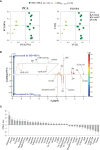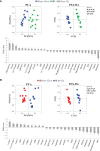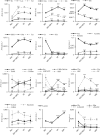Metabolic Adaptations in an Endocrine-Related Breast Cancer Mouse Model Unveil Potential Markers of Tumor Response to Hormonal Therapy
- PMID: 35299741
- PMCID: PMC8921989
- DOI: 10.3389/fonc.2022.786931
Metabolic Adaptations in an Endocrine-Related Breast Cancer Mouse Model Unveil Potential Markers of Tumor Response to Hormonal Therapy
Abstract
Breast cancer (BC) is the most common type of cancer in women and, in most cases, it is hormone-dependent (HD), thus relying on ovarian hormone activation of intracellular receptors to stimulate tumor growth. Endocrine therapy (ET) aimed at preventing hormone receptor activation is the primary treatment strategy, however, about half of the patients, develop resistance in time. This involves the development of hormone independent tumors that initially are ET-responsive (HI), which may subsequently become resistant (HIR). The mechanisms that promote the conversion of HI to HIR tumors are varied and not completely understood. The aim of this work was to characterize the metabolic adaptations accompanying this conversion through the analysis of the polar metabolomes of tumor tissue and non-compromised mammary gland from mice implanted subcutaneously with HD, HI and HIR tumors from a medroxyprogesterone acetate (MPA)-induced BC mouse model. This was carried out by nuclear magnetic resonance (NMR) spectroscopy of tissue polar extracts and data mining through multivariate and univariate statistical analysis. Initial results unveiled marked changes between global tumor profiles and non-compromised mammary gland tissues, as expected. More importantly, specific metabolic signatures were found to accompany progression from HD, through HI and to HIR tumors, impacting on amino acids, nucleotides, membrane percursors and metabolites related to oxidative stress protection mechanisms. For each transition, sets of polar metabolites are advanced as potential markers of progression, including acquisition of resistance to ET. Putative biochemical interpretation of such signatures are proposed and discussed.
Keywords: biomarkers; endocrine-related breast cancer; metabolomics; metabonomics; murine model; therapy resistance.
Copyright © 2022 Araújo, Fabris, Lamb, Lanari, Helguero and Gil.
Conflict of interest statement
The authors declare that the research was conducted in the absence of any commercial or financial relationships that could be construed as a potential conflict of interest.
Figures







Similar articles
-
Hormone-Independent Mouse Mammary Adenocarcinomas with Different Metastatic Potential Exhibit Different Metabolic Signatures.Biomolecules. 2020 Aug 27;10(9):1242. doi: 10.3390/biom10091242. Biomolecules. 2020. PMID: 32867141 Free PMC article.
-
Differential expression of and responsiveness to transforming growth factor-beta (TGF-beta) isoforms in hormone-dependent and independent lines of mouse mammary tumors.Cancer Detect Prev. 1999;23(5):375-86. doi: 10.1046/j.1525-1500.1999.99038.x. Cancer Detect Prev. 1999. PMID: 10468889
-
Carcinoma-associated fibroblasts activate progesterone receptors and induce hormone independent mammary tumor growth: A role for the FGF-2/FGFR-2 axis.Int J Cancer. 2008 Dec 1;123(11):2518-31. doi: 10.1002/ijc.23802. Int J Cancer. 2008. PMID: 18767044
-
Hormone-dependent mammary tumors in mice and rats as a model for human breast cancer (review).Anticancer Res. 1983 Jul-Aug;3(4):273-81. Anticancer Res. 1983. PMID: 6309070 Review.
-
Overview of resistance to systemic therapy in patients with breast cancer.Adv Exp Med Biol. 2007;608:1-22. doi: 10.1007/978-0-387-74039-3_1. Adv Exp Med Biol. 2007. PMID: 17993229 Review.
Cited by
-
Tumor Lipid Signatures Are Descriptive of Acquisition of Therapy Resistance in an Endocrine-Related Breast Cancer Mouse Model.J Proteome Res. 2024 Aug 2;23(8):2815-2829. doi: 10.1021/acs.jproteome.3c00382. Epub 2023 Jul 27. J Proteome Res. 2024. PMID: 37497607 Free PMC article.
-
Ceramide-induced Endoplasmic Reticulum Stress as a Targetable Vulnerability in Endocrine Therapy-Resistant Breast Cancer.bioRxiv [Preprint]. 2025 Aug 22:2025.08.18.670862. doi: 10.1101/2025.08.18.670862. bioRxiv. 2025. PMID: 40894774 Free PMC article. Preprint.
References
LinkOut - more resources
Full Text Sources

